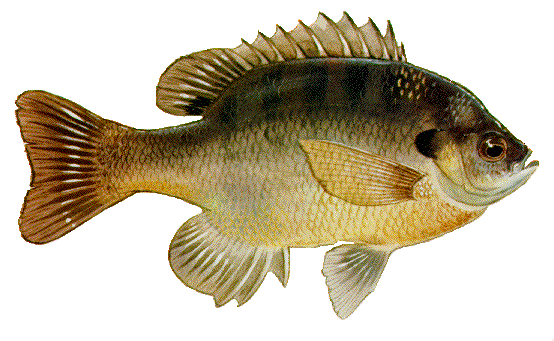SAE: 1.5 hours
This species of sunfish usually consists of many, numerous colors with varying hues and shades. They typically include brown, yellow, black, orange, and sometimes blue or green speckles. Certain places on the pumpkinseed sunfish are commonly colored. For example, they always have a yellow or orange shade on their stomachs and breasts. They defend themselves well with sharp, pin-like pointed dorsal and also anal fins.
Often located in shallow waters, these fish also appreciate some weeds and plants for hiding, or escaping from the direct sunlight. Ponds and small lakes are commonly filled with these pumpkinseed sunfish. They also are most comfortable at a temperature of between thirty nine degrees Fahrenheit and seventy two degrees Fahrenheit. At night these freshwater fish rest close to the ground, but during the warmer daylight hours they tend to be very active and swim around their enclosures in search of food.
Their rapid reproduction rate helps these sunfish a lot because they are quite low on the freshwater fish food chain. Most pumpkinseed sunfish will make a meal out of numerous species and varieties of insects, especially mosquito larvae when it is in season. They also consume mollusks and crustaceans when they can get to them, a readily available source of food also comes from the worms and bait of fishermen. Unfortunately, these fish are also cannibals. They will eat their own kind as well as other small fish that are in the area to sustain themselves. These fish are mostly killed and eaten by birds and mammals, which include humans!
Sunfish, including the pumpkinseed become sexual mature at about the age of two. Colonies of nests that are found on gravel bottoms during late spring and early summer are built by the males. They are very territorial and any females that arrive early will be hastily chased away. When the male decides the time is right, he will meet with a female at his nest. The fish eggs are dropped into a cloud of milt and they stick, settle, and rest on pebbles, gravel, or pieces on the ground below. Once the eggs are settled in the nest, the female leaves everything else is left to the male. Over a certain period of time the males will continue to mate with several other females. In just a few days, the eggs will hatch, but until then the male will guard his nest of eggs with his life. To guard their offspring after hatching, the males try to herd their young in a ball-like cloud. Maintaining the ball-like cloud becomes impossible after a week or two and the offspring part. They have a sufficient amount of energy to move on by themselves, though only a portion of them will make it to adulthood.
On occasion, cross breeding occurs naturally. Pumpkinseed sunnys and bluegills are closely related and look similar too. To fishermen, these fish are great for beginners and experts alike. Though, they are not as commendable as catching a bluegill. The pumpkinseed sunfish is also called a panfish because if you wanted to cook it, the fish could easily fit into a single, normal-sized pan.
Pumpkinseed Sunfish




